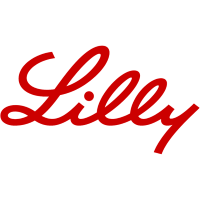
Eli Lilly and Co
NYSE:LLY


| US |

|
Johnson & Johnson
NYSE:JNJ
|
Pharmaceuticals
|
| US |

|
Berkshire Hathaway Inc
NYSE:BRK.A
|
Financial Services
|
| US |

|
Bank of America Corp
NYSE:BAC
|
Banking
|
| US |

|
Mastercard Inc
NYSE:MA
|
Technology
|
| US |

|
UnitedHealth Group Inc
NYSE:UNH
|
Health Care
|
| US |

|
Exxon Mobil Corp
NYSE:XOM
|
Energy
|
| US |

|
Pfizer Inc
NYSE:PFE
|
Pharmaceuticals
|
| US |

|
Palantir Technologies Inc
NYSE:PLTR
|
Technology
|
| US |

|
Nike Inc
NYSE:NKE
|
Textiles, Apparel & Luxury Goods
|
| US |

|
Visa Inc
NYSE:V
|
Technology
|
| CN |

|
Alibaba Group Holding Ltd
NYSE:BABA
|
Retail
|
| US |

|
3M Co
NYSE:MMM
|
Industrial Conglomerates
|
| US |

|
JPMorgan Chase & Co
NYSE:JPM
|
Banking
|
| US |

|
Coca-Cola Co
NYSE:KO
|
Beverages
|
| US |

|
Walmart Inc
NYSE:WMT
|
Retail
|
| US |

|
Verizon Communications Inc
NYSE:VZ
|
Telecommunication
|
Utilize notes to systematically review your investment decisions. By reflecting on past outcomes, you can discern effective strategies and identify those that underperformed. This continuous feedback loop enables you to adapt and refine your approach, optimizing for future success.
Each note serves as a learning point, offering insights into your decision-making processes. Over time, you'll accumulate a personalized database of knowledge, enhancing your ability to make informed decisions quickly and effectively.
With a comprehensive record of your investment history at your fingertips, you can compare current opportunities against past experiences. This not only bolsters your confidence but also ensures that each decision is grounded in a well-documented rationale.
Do you really want to delete this note?
This action cannot be undone.

| 52 Week Range |
570.67
960.02
|
| Price Target |
|
We'll email you a reminder when the closing price reaches USD.
Choose the stock you wish to monitor with a price alert.

|
Johnson & Johnson
NYSE:JNJ
|
US |

|
Berkshire Hathaway Inc
NYSE:BRK.A
|
US |

|
Bank of America Corp
NYSE:BAC
|
US |

|
Mastercard Inc
NYSE:MA
|
US |

|
UnitedHealth Group Inc
NYSE:UNH
|
US |

|
Exxon Mobil Corp
NYSE:XOM
|
US |

|
Pfizer Inc
NYSE:PFE
|
US |

|
Palantir Technologies Inc
NYSE:PLTR
|
US |

|
Nike Inc
NYSE:NKE
|
US |

|
Visa Inc
NYSE:V
|
US |

|
Alibaba Group Holding Ltd
NYSE:BABA
|
CN |

|
3M Co
NYSE:MMM
|
US |

|
JPMorgan Chase & Co
NYSE:JPM
|
US |

|
Coca-Cola Co
NYSE:KO
|
US |

|
Walmart Inc
NYSE:WMT
|
US |

|
Verizon Communications Inc
NYSE:VZ
|
US |
This alert will be permanently deleted.
 Eli Lilly and Co
Eli Lilly and Co
Eli Lilly and Co
Investor Relations
Eli Lilly and Co. has long been a stalwart in the pharmaceutical industry, sculpting its trajectory through innovation and strategic acumen. Founded in 1876 by Colonel Eli Lilly, the company has grown from a small chemical firm into a global powerhouse in developing life-changing medications. Its headquarters in Indianapolis, Indiana, serve as a hub of research and development, where groundbreaking scientific exploration meets business strategy. Eli Lilly thrives on its core pillars of innovation in oncology, immunology, and diabetes care, relying on a deep commitment to scientific discovery and patient care. This emphasis allows it to consistently bring cutting-edge treatments to market, boosting its reputation as a leader in pharmaceuticals and maintaining a strong pipeline of drugs that drive future growth.
The company's business model is principally built around creating proprietary medications that command premium pricing due to their uniqueness and effectiveness. This model sustains Eli Lilly's revenue through a dual approach: serving mature markets with established products and fueling growth with new launches. Patents on flagship drugs protect these revenue streams, allowing the company to invest substantially in research and development, which in recent years prioritizes personalized medicine and biotechnology. Collaborations with academic institutions and other corporations have also been pivotal, accelerating drug development and expanding Eli Lilly's reach across therapeutic areas. Overall, its ability to navigate regulatory frameworks and maintain robust sales and marketing strategies ensures its medications reach patients globally, securing its financial health and influence within the healthcare landscape.

Eli Lilly and Co. has long been a stalwart in the pharmaceutical industry, sculpting its trajectory through innovation and strategic acumen. Founded in 1876 by Colonel Eli Lilly, the company has grown from a small chemical firm into a global powerhouse in developing life-changing medications. Its headquarters in Indianapolis, Indiana, serve as a hub of research and development, where groundbreaking scientific exploration meets business strategy. Eli Lilly thrives on its core pillars of innovation in oncology, immunology, and diabetes care, relying on a deep commitment to scientific discovery and patient care. This emphasis allows it to consistently bring cutting-edge treatments to market, boosting its reputation as a leader in pharmaceuticals and maintaining a strong pipeline of drugs that drive future growth.
The company's business model is principally built around creating proprietary medications that command premium pricing due to their uniqueness and effectiveness. This model sustains Eli Lilly's revenue through a dual approach: serving mature markets with established products and fueling growth with new launches. Patents on flagship drugs protect these revenue streams, allowing the company to invest substantially in research and development, which in recent years prioritizes personalized medicine and biotechnology. Collaborations with academic institutions and other corporations have also been pivotal, accelerating drug development and expanding Eli Lilly's reach across therapeutic areas. Overall, its ability to navigate regulatory frameworks and maintain robust sales and marketing strategies ensures its medications reach patients globally, securing its financial health and influence within the healthcare landscape.
Earnings Calls
Management
Anat Hakim, J.D., serves as the Executive Vice President, General Counsel, and Secretary at Eli Lilly and Company. In her role, she is responsible for overseeing the company's global legal affairs, including litigation, corporate governance, intellectual property, and regulatory matters. Before joining Eli Lilly, Anat Hakim held significant positions at other major corporations. She served as Senior Vice President and General Counsel at WellCare Health Plans, Inc., where she played a critical role in managing legal, regulatory, and compliance matters. Additionally, Hakim has also worked with other prominent companies, such as Abbott Laboratories, where she held various legal leadership positions. Anat Hakim earned her Juris Doctor degree from Harvard Law School and her undergraduate degree from the University of Wisconsin-Madison. Her extensive background in legal matters, particularly in the healthcare and pharmaceutical sectors, underscores her capability in navigating complex legal landscapes, providing strategic guidance, and supporting business goals through effective legal strategy.
Before joining Eli Lilly, Anat Hakim held significant positions at other major corporations. She served as Senior Vice President and General Counsel at WellCare Health Plans, Inc., where she played a critical role in managing legal, regulatory, and compliance matters. Additionally, Hakim has also worked with other prominent companies, such as Abbott Laboratories, where she held various legal leadership positions.
Anat Hakim earned her Juris Doctor degree from Harvard Law School and her undergraduate degree from the University of Wisconsin-Madison. Her extensive background in legal matters, particularly in the healthcare and pharmaceutical sectors, underscores her capability in navigating complex legal landscapes, providing strategic guidance, and supporting business goals through effective legal strategy.
Jacob S. Van Naarden is a notable executive in the pharmaceutical industry, primarily known for his role at Eli Lilly and Company. He serves as the CEO of Loxo Oncology at Lilly, a research and development unit focusing on creating highly selective medicines for patients with genetically defined cancers. Van Naarden joined Eli Lilly following Eli Lilly's acquisition of Loxo Oncology in 2019, where he was instrumental in integrating the company into Lilly and continuing its mission. Before joining Loxo Oncology, Van Naarden held leadership positions in various biotech and pharmaceutical companies. He has a strong background in finance and corporate strategy, having worked at Aisling Capital and serving as Chief Business Officer at both Jazz Pharmaceuticals and The Medicines Company. His expertise in mergers and acquisitions and strategic growth opportunities has been invaluable in his leadership roles. Under his guidance, Loxo Oncology at Lilly has advanced its clinical pipeline, focusing on innovative approaches to precision medicine, developing treatments tailored to specific genetic drivers of cancer. Van Naarden is revered for his strategic vision and commitment to advancing targeted therapies that address unmet medical needs in oncology.
Before joining Loxo Oncology, Van Naarden held leadership positions in various biotech and pharmaceutical companies. He has a strong background in finance and corporate strategy, having worked at Aisling Capital and serving as Chief Business Officer at both Jazz Pharmaceuticals and The Medicines Company. His expertise in mergers and acquisitions and strategic growth opportunities has been invaluable in his leadership roles.
Under his guidance, Loxo Oncology at Lilly has advanced its clinical pipeline, focusing on innovative approaches to precision medicine, developing treatments tailored to specific genetic drivers of cancer. Van Naarden is revered for his strategic vision and commitment to advancing targeted therapies that address unmet medical needs in oncology.
Lucas E. Montarce is an established executive with a significant role at Eli Lilly and Co, a leading pharmaceutical company. As Vice President and Corporate Controller, Mr. Montarce is responsible for overseeing the company's financial operations, ensuring accuracy in financial reporting, and maintaining regulatory compliance. With a strong background in finance, he brings extensive expertise in accounting and financial strategy to his position, contributing to the company's fiscal health and strategic decision-making. His leadership role is critical in managing Eli Lilly's financial performance and supporting its mission to develop innovative healthcare solutions. Mr. Montarce has a reputation for his analytical skills and strategic acumen, fostering financial discipline and driving sustainable growth for the company.
Donald A. Zakrowski is not widely recognized in public domain records as a significant executive or officer of Eli Lilly and Co. It appears that there might be limited information available about him in this context. If you have a specific question about Eli Lilly and Co. or another individual associated with the company, please let me know. Otherwise, it seems that "Donald A. Zakrowski" may not be a prominent figure within Eli Lilly and Co. or there is not enough public information available.

Alonzo Weems served as an executive at Eli Lilly and Company, where he held the position of Senior Vice President and General Counsel. In this role, he was responsible for overseeing the company's global legal compliance, ethics, and enterprise risk management. Weems played a crucial part in ensuring that Eli Lilly adhered to legal standards and regulations while maintaining its ethical commitments. Before becoming the General Counsel, he held various roles within Lilly, demonstrating leadership in corporate law and governance. Weems has a strong background in legal and regulatory issues, contributing significantly to Lilly's strategic initiatives and legal framework. Additionally, Weems is known for his commitment to diversity and inclusion within the corporate environment, advocating for equitable practices in the workplace.


Jeffrey N. Simmons is not associated with Eli Lilly and Co. However, he is known for his role as the CEO of Elanco Animal Health Incorporated. Elanco, which was once a division of Eli Lilly and Co., became an independent company focused on animal health. Jeffrey N. Simmons has been instrumental in leading Elanco through its growth and expansion, particularly during its transition to a standalone company. Simmons joined Elanco in 1989 and has held various leadership positions within the company, contributing significantly to its global development. His leadership is characterized by a strong commitment to innovation, sustainability, and improving food and companionship enriches life. Under his guidance, Elanco has become a significant player in the animal health sector, emphasizing a customer-focused approach and expansion into new markets and technologies. His strategic vision and dedication to company values have earned him recognition in the industry. Simmons holds a bachelor's degree in agricultural economics and has been involved in various industry and community organizations.

Simmons joined Elanco in 1989 and has held various leadership positions within the company, contributing significantly to its global development. His leadership is characterized by a strong commitment to innovation, sustainability, and improving food and companionship enriches life. Under his guidance, Elanco has become a significant player in the animal health sector, emphasizing a customer-focused approach and expansion into new markets and technologies.
His strategic vision and dedication to company values have earned him recognition in the industry. Simmons holds a bachelor's degree in agricultural economics and has been involved in various industry and community organizations.
W. Darin Moody is a notable executive at Eli Lilly and Company, a leading global pharmaceutical company. Throughout his career at Eli Lilly, Moody has been known for his influential leadership and dedication to advancing the company's mission. He has played significant roles in operational and strategic areas, contributing to the development and delivery of innovative medical solutions. His expertise in pharmaceutical operations and strategic planning has been instrumental in steering Eli Lilly's growth and success. Under his leadership, the company has made strides in enhancing its product pipeline and expanding its global footprint. Moody's work has been marked by a focus on innovation, efficiency, and a commitment to improving patient outcomes.

Anne E. White is an accomplished executive in the pharmaceutical industry, known for her leadership at Eli Lilly and Company. She serves as the Executive Vice President of Eli Lilly and Co and is also the President of Lilly Neuroscience. In this capacity, she is responsible for spearheading research and development efforts within the neuroscience division, focusing on innovative treatments and advancing the company's pipeline in areas such as Alzheimer's disease, migraine, and other neurological disorders. Anne E. White has a strong background in biopharmaceuticals, with extensive experience in drug development and commercialization. Throughout her career at Lilly, she has held various roles and has been instrumental in steering projects from concept through to market availability. Her leadership style is characterized by a commitment to scientific excellence, strategic vision, and a passion for improving patient outcomes. She is recognized for her contribution to driving significant progress in neuroscience therapeutics and her dedication to fostering a collaborative and inclusive workplace culture. Her work not only emphasizes scientific innovation but also underscores the importance of understanding and addressing the unmet needs of patients.

Anne E. White has a strong background in biopharmaceuticals, with extensive experience in drug development and commercialization. Throughout her career at Lilly, she has held various roles and has been instrumental in steering projects from concept through to market availability. Her leadership style is characterized by a commitment to scientific excellence, strategic vision, and a passion for improving patient outcomes.
She is recognized for her contribution to driving significant progress in neuroscience therapeutics and her dedication to fostering a collaborative and inclusive workplace culture. Her work not only emphasizes scientific innovation but also underscores the importance of understanding and addressing the unmet needs of patients.

Ilya Yuffa is a prominent executive at Eli Lilly and Company, a global pharmaceutical company. He has held various leadership positions within the company, contributing significantly to its operations and growth. Yuffa has been involved with Eli Lilly for many years, having built a diverse career that spans functions such as finance, sales, marketing, and general management. One of his notable roles was as President of Lilly Bio-Medicines and President of Lilly International, where he was responsible for overseeing and driving the strategic direction of key business units. His leadership was critical in expanding the company's portfolio and market presence worldwide. Yuffa is recognized for his strategic insight and operational expertise, which has helped Eli Lilly navigate complex market challenges and maintain its competitive edge in the pharmaceutical industry. With a strong background in both domestic and international markets, he is highly regarded for his ability to lead cross-functional teams and drive innovation within the company. His educational background includes a degree in business from a reputable institution, further supporting his capabilities in leading complex business operations effectively. Overall, Ilya Yuffa is an influential figure in the pharmaceutical industry, known for his leadership, strategic vision, and dedication to advancing healthcare solutions globally.

One of his notable roles was as President of Lilly Bio-Medicines and President of Lilly International, where he was responsible for overseeing and driving the strategic direction of key business units. His leadership was critical in expanding the company's portfolio and market presence worldwide.
Yuffa is recognized for his strategic insight and operational expertise, which has helped Eli Lilly navigate complex market challenges and maintain its competitive edge in the pharmaceutical industry. With a strong background in both domestic and international markets, he is highly regarded for his ability to lead cross-functional teams and drive innovation within the company.
His educational background includes a degree in business from a reputable institution, further supporting his capabilities in leading complex business operations effectively. Overall, Ilya Yuffa is an influential figure in the pharmaceutical industry, known for his leadership, strategic vision, and dedication to advancing healthcare solutions globally.





























 You don't have any saved screeners yet
You don't have any saved screeners yet
